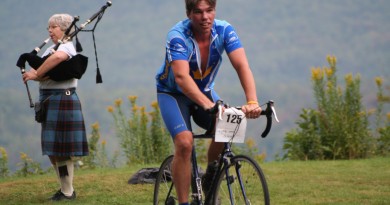Martial Arts: Many Movements, Many Moods
By
Berne Broudy
Posted February 1st, 2000
To win one hundred victories in
one hundred battles is not the
highest skill. To subdue the enemy without fighting is the highest skill.
—Sun Tsu
In Chinese myth, there was an idyllic kingdom where everyone lived in peace and harmony. One day, an evil horned monster appeared in the kingdom and enslaved its people, taking away their freedom. A young man in the community dreamed of a practice—a series of movements—that would make him strong so he could protect himself and his community. He practiced the movements, killed the monster, and restored harmony to his kingdom.
Arthur Makaris, founder of the Vermont Kung Fu Academy, offered me this story as I struggled to understand the martial arts. “Martial” means warlike, but historically, the martial arts evolved from a health regimen developed by Bodhidarma for his fellow monks at the Shaolin monastery in China. Bodhidarma noticed the monks were declining in health. He created the 18 Hands of Lohan, or 18 Lohan Exercises to help them tone up and be better able to fulfill their earthly responsibilities.
As history progressed and war broke out amongst the Chinese feudal states, the monks’ exercises evolved into self-defense techniques. Families took a technique and secretly developed it within family lines, passing it from father to son. Eventually, martial arts armies were formed and the martial arts (now monastery-based, military-based, and family-based) pushed beyond state and national borders.
Chinese martial arts combine with Buddhist philosophy to incorporate the unification of mind, body, and universe as a focus of the practice. Tae Kwon Do, the official military martial art of Korea, became a national sport. The martial arts were called kung fu in China, and developed into karate in Japan, and Tae Kwon Do. The families of martial arts divided and developed into both hard (relying on physical power and strength, direct) and soft (angled, deflective) forms, practiced for defense, art, sport, and health.
Arthur’s explanation mirrors the teaching of martial arts, where understanding has to come from within. Martial arts are a play between yin and yang, hard and soft, internal and external, and the secret lies in the tension between. The definition is not black and white. The martial arts lie somewhere between yoga (on the spiritual end of the spectrum) and Greco-Roman wrestling (on the physical side). They all have a physical aspect focused on making the body strong and limber, and increasing or refining coordination, but each also has an energetic or spiritual side referred to as, but not limited to, the development of chi or ki, internal force, energy and spirit.
“The practice helps students improve themselves by changing the way they communicate, offering them a chance to learn about a different culture, and giving them the tools to investigate and deal open-mindedly with conflict. It also helps them develop discipline and a strong spirit,” says Sue Arborgast, an instructor at the Montpelier Martial Arts Club. Sue combines techniques of several forms to offer her students a system she feels answers their needs as Westerners practicing in the 21st century.
[Arthur Makaris, founder of the Vermont Kung Fu Academy, demonstrates four typical Kung Fu movements. Clockwise from the top: Phoenix; Low Block; Fade Back Block; Bagua Block or Cross Block. Photos by Rose McNulty. ]
“We teach people not to react in fear, not to freeze. We program them to keep thinking in a threatening situation, to overcome the adrenaline rush and consider the options: verbal resolution, flight, or fight, in that order,” explains Sue.
Makaris gives a more philosophical slant: “The greatest conflict is the conscious versus the subconscious. Martial Arts are a tool to help sensitize yourself to your inner conflict. Most students come to a martial arts school because they want something: to defend themselves, mind-body integration, and spiritual enlightenment. Most come because they have fear, and in the process of practicing, the student recognizes and is able to face this deepest aspect of the human condition.”
Though kindness to self and others, honesty, humility, respect, and perseverance are fundamental to the martial arts, the martial arts are undeniably for defending oneself. Makaris’s student, Rose McNulty is clear about what she has learned: “If you don’t intend to protect yourself with the martial arts, you shouldn’t bother doing them.”
There is substantial variation in technique depending on the martial art and the teacher. One internet site for Brazilian jiu-jitsu advertises, “no other art in the world has proven more effective in one-on-one, unarmed, no-rules fighting both in the ring and on the streets.” In contrast, Champlain Valley Aikido director Ben Pincus teaches turning out of the way of the attack, blending with an attack, and using the energy of an attacker to immobilize him. Ben also uses Aikido techniques to teach verbal conflict resolution.
Both McNulty, who has been practicing Kung Fu for five years, and Makaris, who has been practicing martial arts for over 25 years, stress that knowledge of martial arts, in almost all instances, prevents the practitioner from having to engage in physical confrontation.
Because of the great variation amongst forms, choosing a martial art to study is not a simple task. Students and teachers note the importance of taking time to select a form and a teacher that are right for you, and using the heart as well as the head to choose.
McNulty originally turned to martial arts for self-defense. “As a photographer on assignment, I’d get off the subway in Boston or New York, and I’d encounter delirious individuals and feel scared. After this happened several times, I decided I needed a martial art. I went to an Aikido studio to observe, and it wasn’t for me. I checked out Moo Gung Do studio, and thought it was too regimented. Finally, I went to Vermont Kung Fu Academy, met Arthur, and it just had the right feel.”
“All that matters is the teacher, and if the teacher can, over time, help you face yourself,” says Makaris, who teaches the Praying Mantis style of Kung Fu.
Different from learning physical moves for self-defense, studying a martial art is a multi-tiered and lifetime practice. The black belt, which can take five to ten years to attain, signifies the student has reached “beginner” status, has begun the process of integrating and understanding mind, body and breath, and can now begin exploring that process. Any of the martial arts can be very physically demanding, and there will be many emotional and spiritual challenges along the way. It is said that in martial arts, one can overcome one’s opponent with basic technique, but to overcome oneself, one needs advanced technique. As Pincus points out, “the martial arts are art forms that developed in another era, and continue to evolve.”
McNulty confirms, “Kung fu started for me as a physical practice and has brought me other places.”
Despite Hollywood’s help in increasing awareness and popularity of martial arts with Bruce Lee movies and the Karate Kid, less than one-tenth of one percent of Americans practice a martial art, as compared to 10 percent of Scandinavians. In Asia, martial arts training is part of the school curriculum through the age of 10 or 12, after which the student can choose if he or she wishes to continue.
Makaris is quick to point out he abhors the portrayal of martial arts as gross violence. “I do martial arts because it makes me feel good,” he says. “It is a practice that can be started at any time in life and continued into old age.”
Where to learn:
This is a partial list of places to study martial arts in Vermont:
Burlington area:
Vermont Kung Fu Academy
802-878-7888
Aikido of Champlain Valley
802-654-6999 www.aikodovt.org
Aikido Vermont
802-862-9785
Donnelly’s Martial Arts
802-865-1234
Vermont Brazilian Jiu-Jitsu
802-660-4072
Martial Way of Self Defense Center 802-879-2554
Morrisville
Dunlavey’s Black Belt Academy
802-888-8530
Montpelier
Montpelier Martial Arts Club
802-223-6309
Rutland
Vermont Martial Arts Academy
802-773-1373


